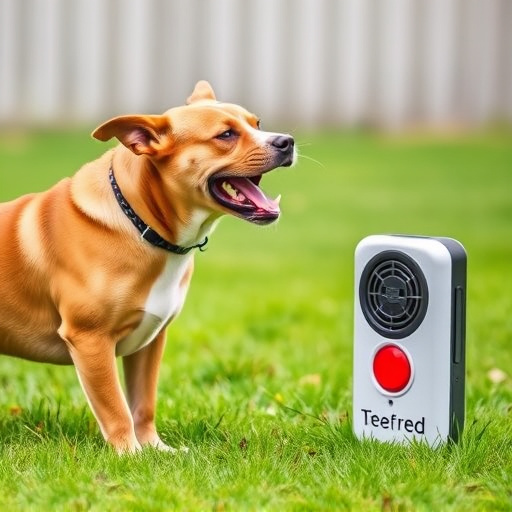Dog defense ultrasonic devices offer a non-lethal solution for aggressive canine behavior, emitting inaudible high-frequency sound waves that irritate dogs and prompt them to flee. Portable ultrasonic devices provide versatility and mobility for various scenarios, while stationary repellents offer continuous protection for larger spaces but lack adaptability. The choice between stationary and mobile depends on individual needs regarding consistency (stationary) versus adaptability (mobile), with the latter appealing to active pet owners needing portable solutions for diverse settings.
“Unleash your peace of mind with a dog defense ultrasonic portable device – a revolutionary tool for pet owners. This comprehensive guide offers a detailed stationary vs. mobile dog repellent comparison, demystifying these innovative solutions. Understand the mechanics behind ultrasonic technology and its effectiveness. Explore the pros and cons of both stationary and mobile options, including range and portability. Learn key factors to consider when choosing the best fit for your situation, ensuring a harmonious coexistence with man’s best friend.”
- Understanding Dog Defense Ultrasonic Devices: How They Work
- Stationary Dog Repellents: Pros, Cons, and Effective Range
- Mobile Dog Repellent Devices: Portability and Versatility Compared
- Making an Informed Choice: Key Factors to Consider for Your Situation
Understanding Dog Defense Ultrasonic Devices: How They Work
Dog defense ultrasonic devices have gained popularity as a non-lethal method to deter and protect against aggressive canine behavior. These innovative tools emit high-frequency sound waves that are inaudible to humans but can be extremely irritating to dogs, causing them to flee or become less inclined to approach. The core principle behind their functionality lies in the ability to manipulate canine perception without causing harm.
When activated, these devices produce ultrasonic vibrations, typically ranging from 25 to 64 kHz, which are projected into the environment. Dogs, with their highly sensitive hearing, perceive these sounds as discomfort or even pain, prompting them to move away. This technology offers a significant advantage over traditional stationary repellents as it provides mobility and versatility. In contrast to fixed devices, portable ultrasonic reps allow users to carry them and adjust their position, making them ideal for various scenarios, whether walking your dog in unfamiliar territories or setting up temporary barriers during outdoor events.
Stationary Dog Repellents: Pros, Cons, and Effective Range
Stationary dog repellents, often in the form of electronic devices or sprayers, are designed to protect your space from unwanted canine intruders. They offer a range of benefits over their mobile counterparts. Firstly, they can provide consistent protection for extended periods without requiring frequent battery changes or manual activation. This makes them ideal for long-term use in gardens, patios, or even indoor areas prone to dog visits. Secondly, stationary repellents typically have a broader effective range, sometimes covering several hundred square feet, ensuring comprehensive protection for larger spaces.
However, there are also drawbacks. These devices might not be as versatile as mobile options, requiring strategic placement and potentially needing multiple units to cover an entire area. Additionally, their effectiveness can be influenced by factors like weather conditions, with rain or snow reducing the range and power of ultrasonic signals. In contrast, a mobile dog repellent allows for easy movement and adjustment, making it suitable for dynamic environments. When considering a stationary vs. mobile dog repellent comparison, the choice depends on your specific needs—whether you prioritize consistent, long-term protection or adaptability and ease of use.
Mobile Dog Repellent Devices: Portability and Versatility Compared
In the stationary dog repellent category, devices are typically installed in fixed locations, relying on their consistent presence to deter dogs. They often use strong scents or sounds that canines find unpleasant. While effective for specific areas, they lack the flexibility to move with you or adapt to different environments. In contrast, mobile dog repellent devices offer unparalleled portability and versatility. These handheld or battery-powered tools allow users to repel dogs on-the-go, whether during walks in new neighborhoods or while enjoying outdoor activities.
Compared to their stationary counterparts, mobile options provide the advantage of adaptability. They can be used in various settings, from parks and trails to backyards and even vehicles. This versatility is particularly appealing for pet owners who enjoy active lifestyles or those facing persistent dog intrusions in specific areas but not others. Additionally, mobile devices offer a non-confrontational approach to dog deterrence, ensuring a safer and more peaceful experience for both humans and dogs alike.
Making an Informed Choice: Key Factors to Consider for Your Situation
When choosing a dog defense ultrasonic portable device, it’s crucial to consider your specific needs and environment. A key factor is whether you require a stationary or mobile solution. For those with fixed spaces like yards or patios, a stationary repellent might be ideal. These devices can cover large areas effectively and are often more affordable. However, they lack portability, meaning you can’t move them easily for outdoor activities or travel.
On the other hand, mobile dog repellents offer versatility. They’re perfect for people who enjoy hiking, camping, or spending time in various outdoor settings. These devices are compact, lightweight, and easy to carry, providing on-the-go protection against aggressive dogs. When making your choice, think about where you’ll be using the device most frequently and select accordingly between a stationary vs. mobile dog repellent.
When choosing a dog defense solution, understanding the differences between stationary and mobile ultrasonic devices is key. While both offer non-lethal deterrents, mobile options excel in portability and versatility, making them ideal for travel or dynamic environments. Stationary repellents, however, provide consistent protection over larger areas. In terms of a Stationary vs Mobile Dog Repellent Comparison, each has its pros and cons, influencing the best choice based on individual needs and circumstances.
